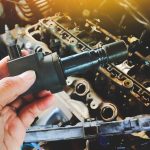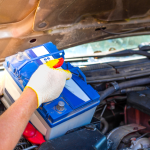Heading out on a road trip can be an exhilarating experience, filled with the promise of adventure, new sights, and unforgettable memories. However, before you hit the open road, it’s essential to ensure your vehicle is in tip-top shape. The last thing you want is to face unexpected car troubles that could put a damper on your journey. That’s where a well-thought-out car maintenance checklist comes in handy!
In this article, we’ll guide you through a simple yet effective seven-item checklist that will help you prep your car for a smooth and safe trip. So buckle up, grab your snacks, and let’s get your ride ready for the journey ahead!
Table of Contents
- Essential Checks for Your Vehicles Performance
- Tire Care Tips to Ensure a Smooth Journey
- Fluid Levels and Their Importance for Long Drives
- Safety Features to Inspect Before Hitting the Road
- Q&A
- Concluding Remarks
Essential Checks for Your Vehicles Performance
Before hitting the open road, it’s crucial to ensure your vehicle is in tip-top shape to avoid any unexpected hiccups during your journey. Start by checking the engine oil level and quality, as well as topping up if necessary. The last thing you want is to overheat your engine. Next, inspect your coolant levels, ensuring they’re at the proper mark to maintain optimal engine temperature. Don’t forget to look at your brake fluid – brakes are vital for safety, so a simple visual check can save you a lot of trouble.
Another important aspect to consider is your tire pressure. Under-inflated tires can lead to poor fuel economy and handling. It’s also a good time to check for any signs of wear or damage on the tire surface. Moving on to the battery, ensure the terminals are clean and free from corrosion, and check for any loose connections. it’s wise to inspect your wiper blades and replace them if they show signs of wear, ensuring clear visibility in rainy conditions. By taking these essential steps, you’ll be well-prepared for your upcoming adventure!
Read More: 10 Tips to Avoid Buying Flood Damaged Cars
Tire Care Tips to Ensure a Smooth Journey
To ensure a trouble-free road trip, it’s essential to pay close attention to your tires. Start with a thorough inspection: check for any signs of wear and tear such as cracks or bulges on the sidewall. Ensuring your tires are properly inflated to the manufacturer’s recommended pressure is vital for fuel efficiency and safety. Additionally, don’t forget to check the tread depth; a simple way to do this is by using the penny test. Insert a penny into the tread with Lincoln’s head facing down; if you can see the top of his head, it’s time to replace your tires.
Regular tire rotations can also extend the life of your tires and ensure even wear. Be sure to schedule these every 5,000 to 7,500 miles. Keeping an eye on your alignment and balancing can help maintain a smooth ride and prevent uneven wear. a quick road trip necessity is to have your spare tire accessible and in good condition. Prepare for unexpected situations by equipping your vehicle with a reliable tire repair kit. A well-maintained set of tires will not only enhance your driving experience but also keep you safe on your adventures.
Fluid Levels and Their Importance for Long Drives
Before embarking on a long drive, checking your car’s fluid levels is essential for a smooth and trouble-free journey. Engine oil, coolant, brake fluid, transmission fluid, and power steering fluid are just a few critical fluids that keep your vehicle running efficiently. Neglecting these can lead to overheating, poor braking performance, or even engine failure. Regularly topping off and replacing fluids not only enhances your car’s performance but also prolongs its lifespan, which can save you money on repairs in the long run.
Here’s a handy checklist to ensure you’re covered before you hit the road:
- Engine Oil: Check the level and condition; change if it’s dirty or low.
- Coolant: Ensure it’s at the correct level to avoid overheating.
- Brake Fluid: Check for proper levels and look for any leaks.
- Transmission Fluid: Make sure it’s clean and filled to the appropriate level.
- Power Steering Fluid: Verify the level to maintain steering precision.
- Windshield Washer Fluid: Keep it topped off for clear visibility.
- Fuel: Don’t forget to fill up before long stretches without stations!
For a more organized assessment, you can use the following table to track your fluid levels:
| Fluid Type | Recommended Level | Notes |
|---|---|---|
| Engine Oil | Max | Change every 5,000 to 7,500 miles |
| Coolant | Max | Check before every long trip |
| Brake Fluid | Min | Change every 2 years |
| Transmission Fluid | Max | Inspect every 30,000 miles |
| Power Steering Fluid | Max | Check alongside oil changes |
| Washer Fluid | Max | Refill as needed |
Safety Features to Inspect Before Hitting the Road
Before hitting the open road, conducting a thorough inspection of your vehicle’s safety features is essential to ensure a smooth journey. Start by examining the brakes, as they are crucial for stopping power. Make sure the brake pads are not worn down and that the brake fluid is at the appropriate level. Next, check your tires for proper inflation and tread depth. Uneven wear or low pressure can lead to blowouts, especially on long trips. Don’t forget to test the lights; ensure that headlights, brake lights, and turn signals are functioning correctly for optimal visibility and safety.
Another critical aspect to check is the wipers. Inspect the wiper blades for wear and replace them if necessary to maintain clear visibility during inclement weather. Additionally, verify that your seatbelts are in good condition and functioning properly, as they’re your first line of defense in an accident. Lastly, familiarize yourself with the emergency kit in your vehicle, which should include items like a flashlight, first aid supplies, and flares. This simple checklist can make a significant difference in your safety and peace of mind while traveling.
Q&A
Q&A: !
Q: Why is it important to check my car before going on a road trip?
A: Ensuring your car is in top condition before a road trip not only enhances your safety but also minimizes the risk of unexpected breakdowns. A little preparation can save you time, money, and stress during your travels.
Q: What are the seven items I should include in my car maintenance checklist?
A: Great question! Here’s a quick rundown of the essential items to check:
- Oil Level and Quality: Check your oil level and quality. If it’s dirty or low, consider changing it.
- Coolant Level: Make sure your coolant is at the proper level to prevent overheating.
- Tire Condition: Inspect your tires for any signs of wear and ensure they are inflated to the correct pressure. Don’t forget to check the spare tire as well!
- Brakes: Listen for unusual sounds when braking and check the brake fluid level.
- Wiper Blades and Fluid: Ensure your windshield wipers are in good shape and fill the washer fluid reservoir.
- Battery Health: Look for corrosion and check the battery terminal connections. If your battery is over three years old, have it tested.
- Lights and Signals: Test all headlights, brake lights, and turn signals to ensure they’re functioning correctly.
Q: How do I check my oil and coolant levels?
A: To check your oil level, wait for your engine to cool, then remove the dipstick, wipe it clean, reinsert it, and remove it again to check the level. For coolant, locate the coolant reservoir (usually a translucent tank) and make sure the fluid reaches the “full” mark.
Q: What should I do if I find a problem with my car?
A: If you discover any issues during your checks, it’s best to consult a qualified mechanic. Whether it’s an oil change, tire replacement, or brake inspection, addressing these problems before your road trip can help ensure a smooth journey.
Q: How long before my trip should I perform these checks?
A: It’s ideal to complete these checks at least a week before your trip. This allows ample time to address any issues and ensures you can hit the road confidently.
Q: Are there any other tips for preparing my car for a long road trip?
A: Absolutely! In addition to your maintenance checklist, consider packing an emergency kit with items like a first aid kit, flashlight, blankets, water, and snacks. Also, familiarize yourself with your route and keep a physical map handy, just in case your GPS fails.
Q: Can I perform these checks myself, or should I take my car to a professional?
A: Many of these checks are simple enough for most car owners to perform themselves, especially with online guides and tutorials. However, if you’re uncertain or uncomfortable, it’s always wise to visit a professional mechanic for peace of mind.
Q: What if I’m planning a very long road trip?
A: For longer trips, consider a more comprehensive vehicle inspection. In addition to the seven items listed, make sure to check the belts and hoses, and consider replacing any filters (like air or fuel) if they haven’t been changed in a while.
Remember, a little preparation goes a long way in ensuring a fun and safe road trip. Happy travels!
Concluding Remarks
As you gear up for your upcoming road trip, remember that a little preparation can go a long way in ensuring a smooth and enjoyable journey. By following this 7-item car maintenance checklist, you can catch potential issues before they become problems, giving you peace of mind as you hit the open road. Regular maintenance not only enhances the performance and safety of your vehicle but also helps you avoid unexpected detours and costly repairs.
So, before you pack your bags and load up the snacks, take a few moments to check off each item on your list. Whether you’re cruising down the coast or exploring the mountains, being proactive about your car’s health can make all the difference. Safe travels, happy adventuring, and may your trip be filled with memorable moments and stunning sights!











